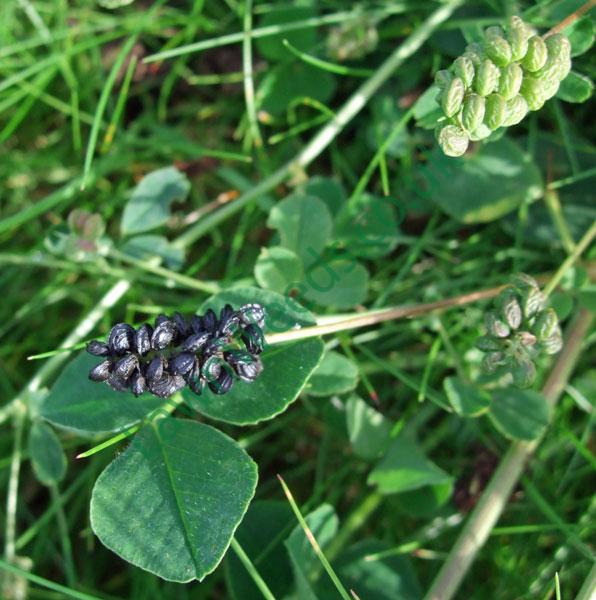 Botanical name: Medicago lupulina
Botanical name: Medicago lupulina
Family: Fabaceae
Aliases: nonesuch, hop clover, hop medic, yellow trefoil
General information
Black medic is a lawn and turf weed that belongs to the legume or clover family of plants and can be both annual or a short-lived perennial.
It is very similar in appearance to lesser trefoil (yellow suckling clover) and is often mistaken for it. The main differences is that black medic can have pointed leaf tips, which are absent on lesser trefoil.
Black medic grows in a variety of conditions including waste areas, bare soil, grassy areas and managed turf. It can be troublesome on dry, undernourished turf in poor conditions.
It has a shallow, fibrous root system and it spreads via seed. The stems, which can spread up to 40 cm are slender and prostrate, but unlike white clover, this weed does not root at intervals.
Like other plants in the clover family (Fabaceae), black medic is a nitrogen fixing plant. This means the plant is able to draw nitrogen gas from the air and store it in the root system.
Black medic identification
- Leaf – The leaves are typical of other clovers and very similar in appearance to those of lesser trefoil. Each leaf bears three leaflets, consisting of 2 lateral and a central leaflet (borne on a short stalk). They are round – oval in shape and measure between 8 – 13 mm across. The leaf margins are finely serrated and have a pointed tip (The pointed tips are absent on lesser trefoil).
- Flower – Black medic produces dense clusters of between 20 – 50 yellow flowers from April to August. Each flowerhead typically measures about 6 – 8 mm across and is a globoid shape. The plant also produces dense clusters of seed pods, which eventually turf black when they reach maturity.
- Root – The root system is shallow and fibrous.
Black Medic Images (click image to enlarge)
More images and free downloads of Black Medic
Prevention and control of black medic
Hand removal is very effective in removing this weed, which is best undertaken when the soil is moist, as the roots are easier to remove.
Encourage a healthy sward by applying adequate nutrition. Turf that is thick and healthy discourages weeds from encroaching.
Ensure the grass clippings are removed when mowing, to help prevent this weed spreading via seed.
Black medic is less sensitive to selective weed killers than other weeds in this family and in many cases a repeat application will be required for complete control. For the best results, choose a selective herbicide that contains mecoprop-p, as it is very effective in controlling weeds in the clover family.
Always try to keep the use of chemicals to a minimum by only treating infected areas of turf or lawns.
Recommended products for black medic
Professional products (The user requires the appropriate certificate/s to apply these products)
Headland Relay Turf (Mecoprop-p, Dicamba, MCPA)
React Ultra (Mecoprop-p, Dicamba, MCPA)
Everris Praxys (Clopyralid, Fluroxypyr, Fluosulam)
Bayer Longbow (Mecoprop-p, Dicamba, MCPA)
Mascot Greenor (Clopyralid, Fluroxypyr, MCPA)
Products available for non-professioanl use (These products are available from garden centres and DIY stores.)
Verdone extra (Clopyralid, Fluroxypyr, MCPA)
Resolva lawn weed killer (2,4-D, Mecoprop-p, MCPA, Dicamba)
Doff lawn spot weeder (2,4-D, Mecoprop-p, Dichlorprop-p)
Weedol lawn weed killer (Clopyralid, Fluroxypyr, MCPA)







